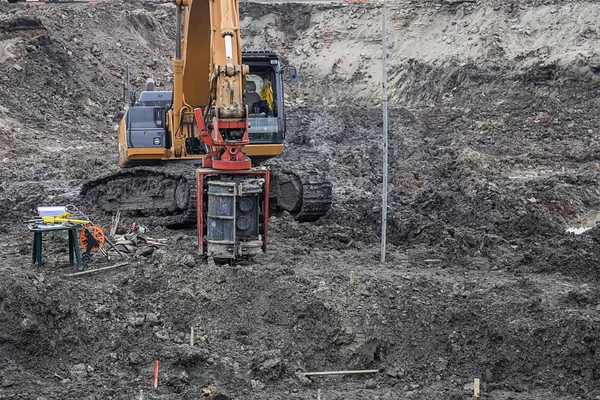Navigating the Intricacies of Geotechnical Eng Projects
An In-depth Review of the Trick Responsibilities of Geotechnical Engineers in Website Characterization and Ground Enhancement Strategies for Design Solutions
Geotechnical designers are essential to the effective implementation of engineering tasks, entrusted with the vital obligations of site characterization and the application of ground improvement strategies. Their work involves a comprehensive evaluation of subsurface problems, employing various testing methods to determine dirt and rock homes. This foundational understanding not only educates style decisions but likewise reduces potential risks related to ground instability. As we explore the diverse roles of these experts, it ends up being evident how their competence shapes the security and effectiveness of engineering services. What particular strategies and assessments attract attention in this important discipline?
Duty of Geotechnical Designers
Geotechnical designers play a pivotal duty in the design and building and construction of infrastructure by evaluating the actions of dirt and rock underneath the surface area - geo tech engineering. Their obligations incorporate examining subsurface conditions to inform layout decisions that guarantee architectural security and safety. By performing detailed analyses of dirt residential properties, including shear leaks in the structure, compressibility, and strength, geotechnical engineers supply critical information that affects the choice of suitable construction materials and methods
In addition to examining dirt auto mechanics, geotechnical engineers are charged with identifying prospective dangers such as landslides, sinkholes, and ground settlements. Their experience assists minimize risks related to these geotechnical sensations, consequently safeguarding both the setting and public security. They also work together very closely with other design techniques, ensuring that geotechnical considerations are integrated right into general project style.
In addition, geotechnical designers involve in the evaluation of existing frameworks, giving referrals for retrofitting and fixings when needed. Their comprehensive understanding of soil-structure communication is vital for the growth of lasting framework solutions. Generally, the duty of geotechnical engineers is integral to the effective understanding of building tasks, ensuring they are risk-free, long lasting, and compliant with regulative requirements.

Site Characterization Processes
Effective site characterization procedures are crucial for understanding the subsurface conditions that influence project layout and execution. Geotechnical engineers utilize a methodical approach to collect, assess, and analyze data concerning groundwater, dirt, and rock characteristics. This process begins with a thorough testimonial of existing literary works and archaeological site information, supplying understandings right into previous website conditions and prospective difficulties.

Information evaluation adheres to fieldwork, where designers utilize geostatistical techniques to analyze findings and produce geological models. This modeling aids in determining possible geohazards, such as landslides or liquefaction, which are vital for threat analysis. Consequently, the results educate design suggestions, making certain that engineering options are both safe and reliable. Through diligent site characterization, geotechnical designers prepared for effective project execution, lessening unanticipated problems and maximizing source appropriation.
Dirt and Rock Testing Approaches
While recognizing subsurface conditions is essential, the selection of ideal soil and rock testing techniques is equally important for precise analysis and style. Geotechnical engineers employ a range of screening strategies to assess the physical and mechanical properties of dirt and rock products.
Laboratory examinations, such as Atterberg limitations, grain dimension analysis, and unconfined compressive stamina examinations, supply crucial information on dirt behavior under different dampness conditions and filling situations. These tests help identify dirt category and predict settlement or shear strength characteristics crucial for structure style.
In-situ screening approaches, consisting of Criterion Infiltration Examinations (SPT), Cone Infiltration Examinations (CPT), and pressure meter examinations, enable engineers to collect information directly from the ground. These methods supply valuable understandings into the dirt's thickness, consistency, and stratification without the requirement for considerable sampling.
Rock testing typically includes core tasting and lab evaluation to analyze residential or commercial properties like uniaxial compressive toughness and rock top quality designation (RQD) With each other, these dirt and rock testing methods allow geotechnical engineers to make enlightened decisions regarding site-specific challenges, making certain the security and security of engineering services.
Ground Improvement Strategies
Ground renovation techniques are necessary for boosting the design homes of dirt, therefore enhancing its load-bearing capacity and reducing settlement. These approaches are important in resolving challenges provided by weak or bothersome soils, which can substantially influence the stability and toughness of structures.
Different ground renovation strategies are utilized, consisting of compaction, grouting, and dirt stabilization. Grouting, on the other Related Site hand, entails infusing a fluid product right into the ground to fill up voids and enhance dirt communication.
Dirt stabilization encompasses an array of approaches, from chemical ingredients to mechanical treatments, focused on boosting the soil's resistance to erosion and contortion. Strategies such as lime stablizing or cement blending modify the buildings of the dirt at a particle degree, enhancing its general performance.
Value of Geotechnical Analyses
Geotechnical analyses play an essential role in the preparation and layout of engineering tasks, as they offer crucial details about the subsurface problems. Comprehending soil residential properties, rock formations, groundwater levels, and potential geohazards is vital for ensuring the security and safety of structures. These assessments allow engineers to make enlightened choices relating to website option, style parameters, and building and construction approaches.
The importance of geotechnical evaluations extends past initial task stages; they contribute in danger administration and cost performance. By determining possible issues early, such as soil settlement, incline instability, or excessive groundwater, engineers can develop proper reduction strategies, minimizing the probability of pricey hold-ups and structural failings. These evaluations sustain conformity with regulative demands and enhance the sustainability of design methods.

Final Thought
Finally, geotechnical designers are important to ensuring the safety and security and stability of design jobs via thorough website characterization and ground renovation strategies. geotechnical eng. Their methodical method to analyzing subsurface conditions, incorporated with their recommendations for efficient ground alteration, significantly boosts soil buildings and load-bearing ability. The know-how of geotechnical engineers not just promotes informed job planning yet also ensures compliance with learn this here now regulations and cultivates reliable interaction amongst stakeholders, eventually adding to successful engineering results
Geotechnical engineers play a critical role in the layout and construction of framework by examining the actions of dirt and rock under the surface. By carrying out detailed analyses of soil homes, consisting of shear compressibility, permeability, and stamina, geotechnical designers supply important data that affects the selection of appropriate construction products and methods.
In addition to evaluating soil technicians, geotechnical designers are tasked with determining possible hazards such as landslides, sinkholes, and ground settlements. Geotechnical designers use helpful hints a systematic technique to collect, review, and translate data pertaining to rock, dirt, and groundwater features. By recognizing possible issues early, such as dirt settlement, incline instability, or extreme groundwater, designers can design ideal mitigation techniques, lowering the possibility of pricey delays and structural failings.